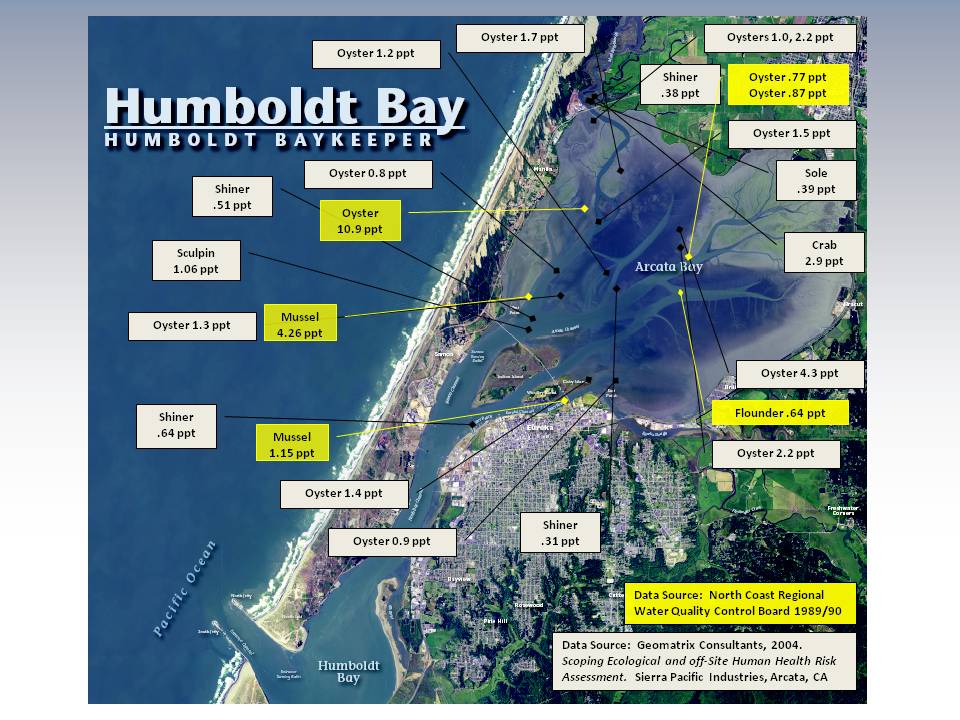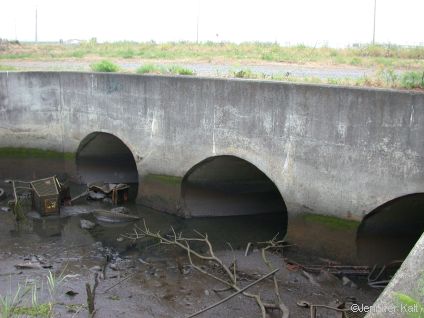Humboldt Bay Dioxin Sampling Locations and Results: Shellfish & Fin Fish

Click here to enlarge.
 Humboldt Waterkeeper addresses water pollution on a case-by-case basis, and provides information to encourage residents to take action to address the problem of toxics in our environment. Historic industrial activity continues to impact the Bay and adjacent waterways as well as human health and the area’s economy. Dioxins, heavy metals, petroleum products, and other contaminants persist in areas where they were used in the past, and continue to enter Humboldt Bay and coastal waters through stormwater and groundwater discharges. Humboldt Waterkeeper works to stop this ongoing problem by seeking cleanup of these sites. A major focus of Humboldt Waterkeeper’s Toxics Initiative is the past use of wood preservatives at dozens of lumber mills that once lined the shores of the Bay and its tributaries. The mills used the chemical pentachlorophenol (also known as "penta") which led to the release of contaminants such as dioxins and furans. Accidental spills and illegal dumping of these chemicals resulted in soil and water contamination. For example, the former Simpson Plywood Mill, and an adjacent drainage swale that discharges directly into Humboldt Bay, was heavily contaminated by dioxins and furans. Through Humboldt Waterkeeper’s Toxic Initiative, this ongoing threat to Humboldt Bay was identified, and has been the subject of clean up activities to eliminate this source of dioxin.In 2006, Humboldt Waterkeeper petitioned the State Water Resources Control Board to add Humboldt Bay to California’s Threatened and Impaired Waters list under Section 303(d) of the Clean Water Act. As a result, Humboldt Bay was listed for dioxins in 2007. Humboldt Bay was listed as Impaired by PCBs under Section 303(d) of the Clean Water Act in 2002, based on levels of PCBs found in fish tissue. PCBs have been demonstrated to cause a variety of serious health effects, including cancer and serious effects on the immune system, reproductive system, nervous system, and endocrine system. Click HERE for more info on PCBs and their health effects. In 2012, a statewide survey of coastal fish found the highest mercury levels in Humboldt Bay leopard shark. In 2016, the California Environmental Protection Agency funded our Humboldt Bay Mercury Assessment to study mercury levels in fish and to identify communities most at risk of exposure. Phase I of this study was completed in 2018, and Phase II was funded in 2019.
Humboldt Waterkeeper addresses water pollution on a case-by-case basis, and provides information to encourage residents to take action to address the problem of toxics in our environment. Historic industrial activity continues to impact the Bay and adjacent waterways as well as human health and the area’s economy. Dioxins, heavy metals, petroleum products, and other contaminants persist in areas where they were used in the past, and continue to enter Humboldt Bay and coastal waters through stormwater and groundwater discharges. Humboldt Waterkeeper works to stop this ongoing problem by seeking cleanup of these sites. A major focus of Humboldt Waterkeeper’s Toxics Initiative is the past use of wood preservatives at dozens of lumber mills that once lined the shores of the Bay and its tributaries. The mills used the chemical pentachlorophenol (also known as "penta") which led to the release of contaminants such as dioxins and furans. Accidental spills and illegal dumping of these chemicals resulted in soil and water contamination. For example, the former Simpson Plywood Mill, and an adjacent drainage swale that discharges directly into Humboldt Bay, was heavily contaminated by dioxins and furans. Through Humboldt Waterkeeper’s Toxic Initiative, this ongoing threat to Humboldt Bay was identified, and has been the subject of clean up activities to eliminate this source of dioxin.In 2006, Humboldt Waterkeeper petitioned the State Water Resources Control Board to add Humboldt Bay to California’s Threatened and Impaired Waters list under Section 303(d) of the Clean Water Act. As a result, Humboldt Bay was listed for dioxins in 2007. Humboldt Bay was listed as Impaired by PCBs under Section 303(d) of the Clean Water Act in 2002, based on levels of PCBs found in fish tissue. PCBs have been demonstrated to cause a variety of serious health effects, including cancer and serious effects on the immune system, reproductive system, nervous system, and endocrine system. Click HERE for more info on PCBs and their health effects. In 2012, a statewide survey of coastal fish found the highest mercury levels in Humboldt Bay leopard shark. In 2016, the California Environmental Protection Agency funded our Humboldt Bay Mercury Assessment to study mercury levels in fish and to identify communities most at risk of exposure. Phase I of this study was completed in 2018, and Phase II was funded in 2019. On Nov. 10, the Humboldt Bay Harbor, Recreation, and Conservation District unanimously approved the environmental analysis and granted a permit to Union Pacific Railroad for cleanup of the former G&R Metals property on the Eureka waterfront. The site, located at 701 First Street, has been fenced off for years while being monitored and assessed in preparation for the cleanup.
Both the upland portion of the site and the adjacent intertidal mudflats in Humboldt Bay are contaminated by PCBs (polychlorinated biphenyls), metals, and PAHs (polycyclic aromatic hydrocarbons) from decades of use as a metal salvage yard, which included metals reclamation from transformers, automobile dismantling and wrecking, storage of batteries, radiators, etc.
The District incorporated limited dioxin sampling in response to Humboldt Baykeeper’s comments on the project. Although this site is not a known or suspected source of dioxin contamination, sediment sampling conducted by the Regional Water Quality Control Board in 2007 found elevated levels adjacent to the site. The sampling conducted as a result of the Harbor District’s actions will provide valuable information on dioxin levels in this portion of Humboldt Bay.
Sources of information about the health effects and environmental effects of dioxin.
Dioxins and their Effects on Human Health
World Health Organization (WHO)
Dioxins
National Institute of Environmental Health Sciences (NIEHS)
Summary and Biography of Dioxin Toxicity
Center for Ethics and Toxins
Environmental Toxics and Lumber Mill Sites
Ecological Rights Foundation
What is dioxin and where does it come from?
Dioxins are a family of chemicals that are some of the most toxic substances known. Dioxin forms as a by-product during the heating of mixtures of chlorine and organic compounds in industrial processes, such as the bleaching of paper pulp or the manufacturing of vinyl plastics (PVC). Unfortunately, dioxin is extremely toxic and very slow to break down, resulting in a very dangerous, although unintended, consequence of modern industry.
Why is dioxin a problem in Humboldt Bay?
Until the 1980s, many Humboldt County lumber mills used a chemical called pentachlorophenol, or "penta," as a wood preservative. The production of penta creates dioxin, leaving the wood preservative laden with dioxin. Lumber mills using penta employed large dip tanks and spray booths to apply penta - and dioxin - not only to lumber but also to the coastal environment.
Although the EPA banned the use of penta in 1984, spills, leaks, and even deliberate dumping had already polluted soils and groundwater at many sites. Since dioxin takes generations to break down, contamination remains at former industrial sites and continues to impact the Bay through runoff, erosion, and underground water exchange.
What does dioxin do to people and the environment?
Dioxin has a wide range of negative impacts for people and other species. Cancer, birth defects, and neurological problems can result from very low levels of exposure. Additionally, parents can pass on toxic impacts to their children, resulting in significant nervous system problems and developmental disorders. Dioxin has also been linked to learning disabilities, immune system disorders, diabetes, lung problems, and skin disorders.
Beyond humans, research has demonstrated that fish, marine mammals, and birds are highly sensitive to dioxin. The effects on these critters are principally reproductive and developmental but may also include problems with metabolism and immune system function. Bird eggs have been shown to suffer from increased mortality at dioxin levels as low as two parts per trillion (2ppt). Coho salmon have been found to be particularly sensitive to dioxin; juveniles can spend up to 2 years in Humboldt Bay before heading out to sea.
What does it mean for Humboldt Bay to be "listed" for dioxin?
The Environmental Protection Agency monitors U.S. waters for contamination in order to protect our health and environment. In California, the State Water Resources Control Board does the preliminary analysis for the EPA and recommends a list of "impaired" water bodies every two years. This process is required by section 303(d) of the Clean Water Act and the list is often called the 303(d) list.
Once a waterbody is listed as impaired by a particular pollutant, the agencies are required to further research the problem and eventually set standards for preventing further pollution. The listing itself, however, does not impose any additional regulations or restrictions on local businesses or municipalities. It affirms the need for clean-up, enabling local agencies to seek funding for site remediation and restoration that would otherwise be unavailable.